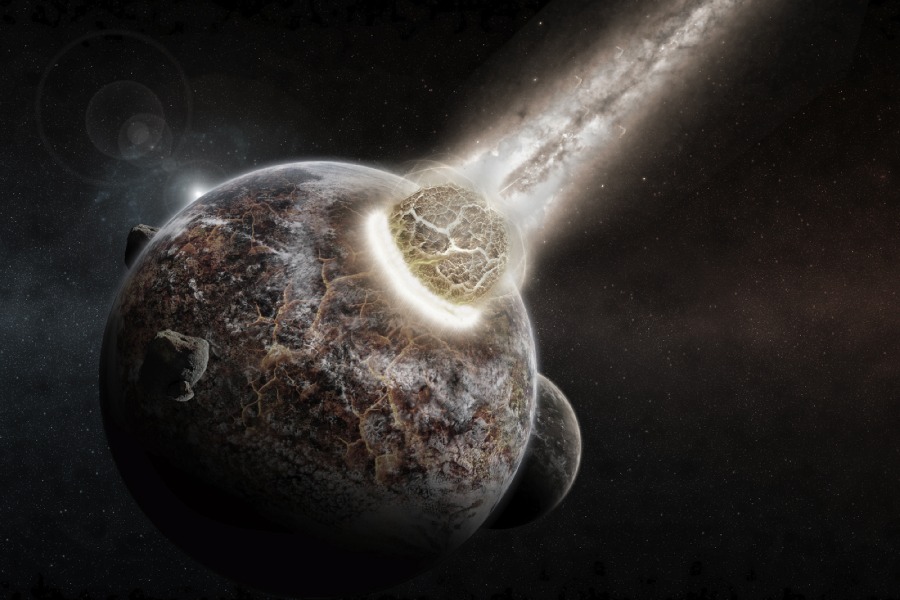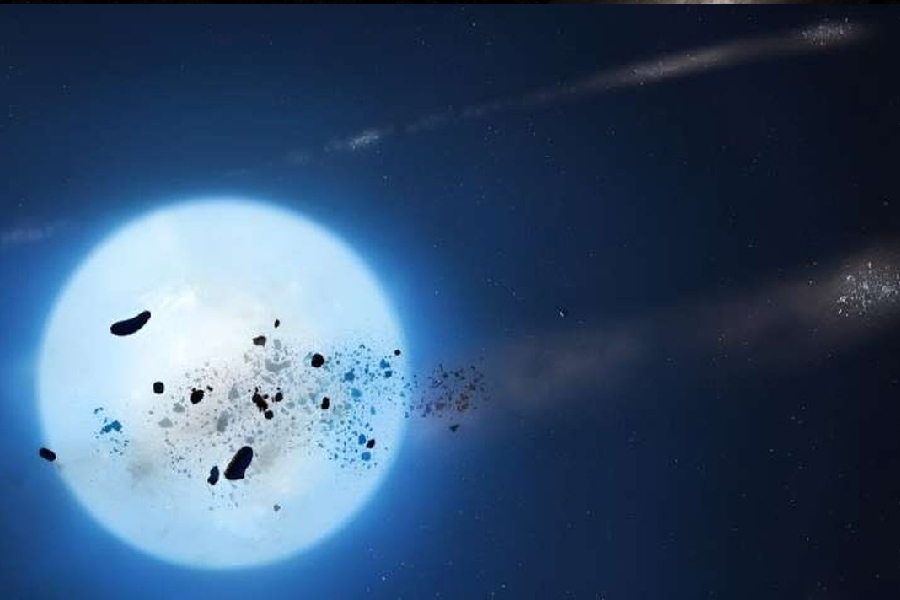Our Solar System is home to a diverse family of planets, from the rocky worlds like Earth to the gas giants like Jupiter. But before the planets, as we know them, existed, more fundamental objects were present in the early solar nebula called planetesimals. But what is a planetesimal?
In this article, we’ll embark on an exploratory journey into the little-known realm of these primordial building blocks to learn the planetesimal meaning. Uncover the secrets behind obscure objects and the planetesimal theory representing the first steps toward creating the planets we call home.

What Is a Planetesimal?
A planetesimal is a small celestial body that forms during the early stages of planetary formation in a protoplanetary disk. These objects are typically composed of dust, ice, and other materials, ranging in size from several miles to hundreds of miles in diameter.
Planetesimals are considered building blocks in the process of planetary accretion. They collide and merge to eventually form planets or other larger celestial bodies within a developing Solar System.
But what is a protoplanetary disc? A protoplanetary disc is a rotating disk of gas and dust surrounding a young star, from which planets and other celestial bodies may form through accretion. Now, let’s learn about the protoplanet hypothesis.
Formation Theory of Planetesimals
Nebular hypothesis
The nebular hypothesis proposes that planets formed from a rotating cloud of gas and dust called the solar nebula. This nebula originated from the remnants of a giant molecular cloud that collapsed due to its own gravity.
As the nebula contracted, its rotation speed increased, causing it to flatten into a protoplanetary disk. Within this disk, dust grains collided and stuck together, forming larger and larger objects called planetesimals.
Gravitational instability model (GIM)
The gravitational instability model suggests that planetesimals formed directly from the gravitational collapse of dense regions within the protoplanetary disk. These dense regions resulted from turbulence or instabilities in the disk.
According to this model, their self-gravity overcame other forces when the dense regions became massive enough. This caused them to contract and form solid bodies called planetesimals.
Collisional accretion model (CAM)
Dust coagulation
The collisional accretion model proposes that planetesimals formed through a series of collisions and sticking processes involving dust grains and larger bodies. Initially, dust grains collided and stuck together through electrostatic and van der Waals forces, forming larger and larger objects.
Growth to planetesimals
As these objects grew in size, their relative velocities increased, leading to more energetic collisions. Eventually, these collisions resulted in the formation of planetesimals, which are solid bodies ranging from a few miles to hundreds of miles in size.
The Role in Planet Formation
Building blocks for planets
Planetesimals are considered the building blocks of planets in our Solar System. They are the initial solid bodies that formed from the protoplanetary disk surrounding the young Sun.
These objects provided the necessary raw materials for planet formation through subsequent accretion and collision processes. Without the existence of planetesimals, the formation of planets as we know them would not have been possible within the current theoretical framework.
Accretion and collision processes
Once planetesimals formed, they began to interact gravitationally, leading to further growth and eventual planet formation. This process is known as accretion, where planetesimals collide and merge, forming larger and larger bodies.
As these bodies grew, their gravitational fields became stronger, allowing them to capture more and more material from the surrounding disk. Collisions between planetesimals played a crucial role in shaping the final characteristics of the planets. Violent collisions could lead to the formation of moons, while gentler mergers contributed to the growth of planetary cores and the acquisition of atmospheres.
Gravitational interactions and orbital dynamics
Planetesimals not only played a role in the growth of planets but also influenced their orbital dynamics and final configurations. Through gravitational interactions, planetesimals could perturb the orbits of larger bodies, leading to orbital migrations and reshaping the architecture of planetary systems.
These interactions also helped to clear out remaining debris from the protoplanetary disk. This allowed for the formation of stable orbits and the eventual formation of the Asteroid Belt and Kuiper Belt.
The gravitational interactions between planetesimals and larger bodies also played a role. They contributed to the delivery of water and other volatile compounds to the inner planets. This shaped their potential for habitability.
Types of Planetesimals
Planetesimals can be categorized into various types based on their composition, formation mechanisms, and locations within the protoplanetary disk. Some of the main types include:
- Rocky planetesimals: Composed primarily of silicate rocks and metals, these planetesimals formed in the inner regions of the protoplanetary disk. They served as building blocks for terrestrial planets.
- Icy planetesimals: These planetesimals form in the outer, colder regions of the disk. They were rich in ice, such as water, methane, and ammonia. These planetesimals contributed to the formation of gas giant planets and their icy moons.
- Carbonaceous planetesimals: Containing significant amounts of organic compounds and volatile elements, these planetesimals are thought to have played a role. They may have delivered water and organic materials to terrestrial planets.
- Differentiated planetesimals: Some larger planetesimals may have experienced internal heating and melting. This could have led to differentiation into distinct layers, such as a rocky core and an icy mantle.

Characteristics of Planetesimals
Mass distribution
The mass distribution of planetesimals is believed to have followed a power-law, with smaller objects being more numerous than larger ones. This distribution is thought to have arisen from the accretion process itself.
The exact slope of the mass distribution curve is still debated. However, it’s thought to have had a significant impact on both the efficiency of planet formation and the eventual masses of the planets.
Composition
The composition of planetesimals was determined by their formation location within the protoplanetary disk. Closer to the Sun, planetesimals were dominated by rocky materials like silicates and metals.
Further out, icy materials like water, methane, and ammonia became more abundant, forming icy planetesimals. Trace amounts of organic compounds were also present, especially in the outer regions.
Shape
Planetesimals are thought to have had irregular, elongated, or even fractal-like shapes, especially in their early stages. This is due to the random nature of the accretion process and the low gravitational forces involved.
As they grew larger, their shapes likely became more spherical due to the increasing influence of self-gravity. However, some larger planetesimals may have retained irregular shapes due to spin or collisional processes.
Size range
As mentioned, the planetesimals’ size range is typically from a few miles to several hundred miles in diameter. This range is based on theoretical models and observations of asteroids and Kuiper Belt objects, which are thought to be remnants of the planetesimal population.
Smaller objects, known as pebbles or boulders, are believed to have existed but were quickly accreted by larger planetesimals. Larger bodies exceeding a few hundred kilometers are generally referred to as protoplanets rather than planetesimals.
But what is a protoplanet? A protoplanet is a large celestial body in the early stages of formation within a protoplanetary disk, which eventually develops into a planet through the accretion of matter.
So, the protoplanet vs planetesimal difference is that a protoplanet is a larger body in the early stages of planetary formation within a protoplanetary disk. At the same time, a planetesimal is a smaller, solid object believed to be a building block of planets, typically ranging miles in size.
Planetary System Evolution
Delivery of volatiles and organics
Planetesimals played a crucial role in delivering volatile compounds and organic materials to the inner regions of the protoplanetary disk. They contributed to the formation and evolution of terrestrial planets.
Icy and carbonaceous planetesimals from the outer disk regions could have been scattered inwards by gravitational perturbations. They may have collided with and seeded the inner planets with water, carbon, and other important compounds.
This delivery process is thought to have been a key factor. It helped establish the conditions necessary for the emergence of life on planets like Earth.
Depletion and dispersal processes
As planets formed and gained significant mass, their gravitational influences grew stronger. This led to depletion and dispersal processes within the planetesimal population.
Gravitational interactions with the larger planets could have ejected some planetesimals from the planetary system. Others were perturbed into highly eccentric orbits, causing them to collide with planets or the Sun.
These processes gradually cleared out the remaining planetesimals. They left behind the Asteroid Belt, Kuiper Belt, and other remnant populations scientists observe today.
Dynamical interactions and collisions
Orbital evolution
Dynamical interactions between planetesimals and the growing protoplanets played a crucial role in shaping the orbital architecture of planetary systems. Gravitational perturbations could have caused planetesimals to migrate, altering their orbits and potentially leading to collisions or ejections.
Planetary collisions
In the early stages of planetary formation, collisions between large planetesimals and protoplanets were frequent and violent. These collisions could have led to the formation of moons, the stripping of planetary atmospheres, and the exchange of material between bodies.
Late Heavy Bombardment
The Late Heavy Bombardment, a period of intense meteorite impacts on the inner planets, is thought to have been caused by the gravitational perturbations of planetesimals in the Solar System’s outer regions. This event likely shaped the surfaces of the terrestrial planets and may have influenced their potential for habitability.
Conclusion
What is a planetesimal? They are fundamental celestial bodies that play a crucial role in the formation and evolution of our Solar System. They emerged from the protoplanetary disk as small solid objects composed of dust, ice, and other materials.
Through processes such as accretion and collision, planetesimals grew in size and complexity, eventually serving as the building blocks for planets. Their interactions with protoplanets and other celestial bodies influenced the dynamics and architecture of the Solar System, shaping its final characteristics.
As scientists’ understanding of planetesimals continues to evolve, our comprehension of the intricate processes that govern the formation and development of planetary systems throughout the universe also evolves. This ongoing research sheds light on the origins and diversity of celestial bodies across the cosmos.
